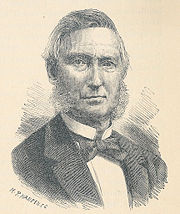
Peter Ludvig Panum
Encyclopedia

Rønne
Rønne is the largest town on the Danish island of Bornholm in the Baltic Sea. It has a population of 13,904 . Once a municipality in its own right, it is now the administrative centre of the Bornholm municipality....
. The Panum Institute
Panum Institute
The Panum Institute is a part of the University of Copenhagen, Denmark. It is a large building complex and houses the Faculty of Health Sciences...
in Copenhagen
Copenhagen
Copenhagen is the capital and largest city of Denmark, with an urban population of 1,199,224 and a metropolitan population of 1,930,260 . With the completion of the transnational Øresund Bridge in 2000, Copenhagen has become the centre of the increasingly integrating Øresund Region...
is named in his honor.
In 1846 he was chosen by the government to undertake research of a measles
Measles
Measles, also known as rubeola or morbilli, is an infection of the respiratory system caused by a virus, specifically a paramyxovirus of the genus Morbillivirus. Morbilliviruses, like other paramyxoviruses, are enveloped, single-stranded, negative-sense RNA viruses...
epidemic
Epidemic
In epidemiology, an epidemic , occurs when new cases of a certain disease, in a given human population, and during a given period, substantially exceed what is expected based on recent experience...
in the Faroe Islands
Faroe Islands
The Faroe Islands are an island group situated between the Norwegian Sea and the North Atlantic Ocean, approximately halfway between Scotland and Iceland. The Faroe Islands are a self-governing territory within the Kingdom of Denmark, along with Denmark proper and Greenland...
. As a result of his investigations he published a classic treatise titled "Observations Made During the Epidemic of Measles on the Faroe Islands in the Year 1846". Later he studied with Rudolf Virchow
Rudolf Virchow
Rudolph Carl Virchow was a German doctor, anthropologist, pathologist, prehistorian, biologist and politician, known for his advancement of public health...
at the University of Würzburg
University of Würzburg
The University of Würzburg is a university in Würzburg, Germany, founded in 1402. The university is a member of the distinguished Coimbra Group.-Name:...
(1851), and with Claude Bernard
Claude Bernard
Claude Bernard was a French physiologist. He was the first to define the term milieu intérieur . Historian of science I. Bernard Cohen of Harvard University called Bernard "one of the greatest of all men of science"...
in Paris
Paris
Paris is the capital and largest city in France, situated on the river Seine, in northern France, at the heart of the Île-de-France region...
(1852-53). From 1855 to 1864 he was a professor at the University of Kiel
University of Kiel
The University of Kiel is a university in the city of Kiel, Germany. It was founded in 1665 as the Academia Holsatorum Chiloniensis by Christian Albert, Duke of Holstein-Gottorp and has approximately 23,000 students today...
, afterwards relocating to the University of Copenhagen
University of Copenhagen
The University of Copenhagen is the oldest and largest university and research institution in Denmark. Founded in 1479, it has more than 37,000 students, the majority of whom are female , and more than 7,000 employees. The university has several campuses located in and around Copenhagen, with the...
as professor of physiology, where he spent the remainder of his career.
Panum is acknowledged as being the first person to perform systematic and comprehensive studies of endotoxin
Endotoxin
Endotoxins are toxins associated with some Gram-negative bacteria. An "endotoxin" is a toxin that is a structural molecule of the bacteria that is recognized by the immune system.-Gram negative:...
, which he referred to at the time as "putrid poison". He believed that this substance was responsible for signs and symptoms observed in patients with sepsis
Sepsis
Sepsis is a potentially deadly medical condition that is characterized by a whole-body inflammatory state and the presence of a known or suspected infection. The body may develop this inflammatory response by the immune system to microbes in the blood, urine, lungs, skin, or other tissues...
.
In his studies of binocular vision
Binocular vision
Binocular vision is vision in which both eyes are used together. The word binocular comes from two Latin roots, bini for double, and oculus for eye. Having two eyes confers at least four advantages over having one. First, it gives a creature a spare eye in case one is damaged. Second, it gives a...
, the eponymous "Panum's fusional area" is derived. This term is defined as the area on the retina
Retina
The vertebrate retina is a light-sensitive tissue lining the inner surface of the eye. The optics of the eye create an image of the visual world on the retina, which serves much the same function as the film in a camera. Light striking the retina initiates a cascade of chemical and electrical...
of one eye
Human eye
The human eye is an organ which reacts to light for several purposes. As a conscious sense organ, the eye allows vision. Rod and cone cells in the retina allow conscious light perception and vision including color differentiation and the perception of depth...
over which a point-sized image can range, while still being able to provide a single image with a specific point of stimulus on the retina of the other eye. Therefore, the region in visual space that we perceive "single vision" is Panum's fusional area, and objects in front and behind this region exist in physiological diplopia
Diplopia
Diplopia, commonly known as double vision, is the simultaneous perception of two images of a single object that may be displaced horizontally, vertically, or diagonally in relation to each other...
(double vision).

